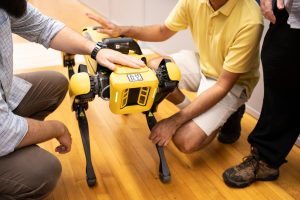Study finds bilingual babies’ brains work differently; bilingual students speak about experiences
October 28, 2022
Infants raised to be bilingual use different parts of their brains when shifting attention to better adapt to hearing two languages, according to a study conducted by a UT researcher.
In the study published earlier this year, monolingual and bilingual 6- and 10-month-olds performed tasks that tested their attention and memory, skills children use to learn languages. Although both groups of babies performed equally, monolingual children activated the right frontal region of their brain, which is used for attention-related tasks, while bilingual babies activated the left frontal region, which is associated with language processing, study author Maria Arredondo said.
Despite the task not relating to language, because bilingual babies are exposed to more language mixing, their left frontal region is activated more overall, said Arredondo, a human development and family sciences assistant professor.
Lucia Bonnin, a native Spanish speaker, said she thought the process of learning English in elementary school improved her learning abilities.
“When I was little, I had to learn math in English, and that was very challenging,” business freshman Bonnin said. “Learning it in my second language gave me a deeper understanding of the language and made me work harder.”
Keziah Bejo said she learned Tagalog when she was about 13 after moving to the Philippines when she was 11.
“(It) was very integral to connecting me to my family, my classmates, just people around me,” human ecology junior Bejo said. “It’s so rewarding, fulfilling to be at the grocery and hear a family speaking Tagalog next to me, and I’ll interject or say something in Tagalog and their whole aura and personality changes because now they realize that you’re one of them.”
About 21.5% of Americans speak languages other than English in their households, according to the 2020 Census Bureau. Arredondo said she hopes to see an increased normalization of bilingualism in the United States.
“(When children) see that their language is not accepted outside of the home, then they might choose not to speak that language,” Arredondo said. “Kids pick up on those things from very early on, as early as like three, four years old. They see people interacting, and they can pick up on what (language) has the most prestige.”
Arredondo said some parents think teaching kids multiple languages will impede their development, but she hopes increased awareness will change that.
“There are no delays in hitting those marks like when they produce the first language, when they produce the first word,” Arredondo said.
Bonnin said as an international student from Mexico, speaking Spanish helped her navigate the social landscape of Austin, but being bilingual has opened her up to making friends in a variety of groups.
“(With Spanish speaking) organizations, I feel more a sense of belonging,” Bonnin said. “I have also made friends that only speak English, and those friendships are also very valuable. But it’s just very interesting because I get to go back and forth and explore those two different sides of my language abilities.”















